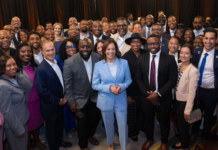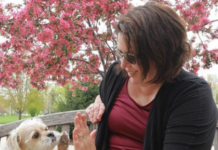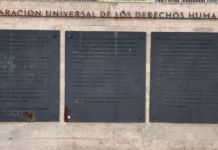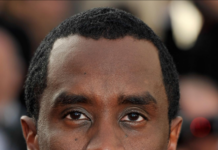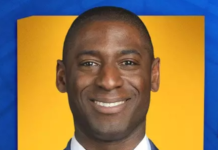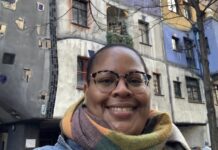Originally published by The 19th. This Hispanic Heritage Month, we’re telling the untold stories of women, women of color and LGBTQ+ people. Sign up for our daily newsletter.
When Carolina Montaño began medical school she never questioned if she belonged there. In Colombia, there was no reason to.
“I was like everyone else. The concept of being a minority or different didn’t cross my mind,” she said.
Montaño was 20 years old and halfway through her studies when her family fled the country in 2000, seeking asylum in the United States because of threats against her father, who was involved in local politics. They settled in Miami, where she learned that none of the coursework she had completed would count toward becoming a doctor. She had to get an American undergraduate degree before even applying to medical school. She had to learn English.
“My dream of being a doctor — that was unwavering,” she said. “But figuring out how was tricky.”
She began English classes at what was then known as Miami-Dade Community College. In a Barnes & Noble, she found a book about how to get into medical school, which she read cover to cover, dictionary in hand. After a year of study, she left Miami, enrolling as a premed student at Brigham Young University in Utah. Montaño didn’t know a single person in the state, and had never been that far west — let alone lived in a place where so few people spoke Spanish.
Montaño would often hear from people at school that she wasn’t smart enough to become a physician or that committing to such a demanding profession would prevent her from being a good mother. She did her best to ignore them. ”I was super Teflon,” she recalled. If she just kept working at it, she told herself, she could finally become a doctor.
Now, Montaño is a scientist at Johns Hopkins University and a practicing pediatric clinical geneticist. It’s a dream job. But she’s conscious of what it took for her to make it to this point — and of how few people like her have had the same opportunity.
“Most people who see me don’t assume I’m a physician,” she said. “When people think of scientists, when they think of doctors, they don’t tend to immediately think of Latinas.”
Latinx people have for years made up the fastest-growing segment of the U.S. population and currently constitute close to 1 in 5 people in the country. But they remain severely underrepresented in the physician workforce.
In the 2014 to 2018 period, only 6 percent of doctors in America identified as Latino, Latina or Latine, according to one recent analysis from the University of California, Los Angeles. Another analysis, conducted by the American Association of Medical Colleges using 2022 survey data, found similar disparities. Per that paper, 6.9 percent of doctors identified as Hispanic, compared with 63.9 percent of doctors who were White — though about 57.8 percent of Americans are White — and 20.6 percent who were Asian, though 7 percent of Americans are Asian. Only 5.7 percent of doctors were Black, though Black Americans make up about 12 percent of the population. That analysis did not look at race and gender in tandem.
The issue is particularly acute among women. The UCLA analysis found that only 2 percent of all physicians in the United States were Latina.
The disparity has remained true for decades, and it’s one that some worry could grow after a Supreme Court decision prohibiting the use of race in selective college admissions, including in medical schools. The American Medical Association, a physician trade group, said the June decision “will translate into a less diverse physician workforce.” A vast body of research links increased racial diversity among doctors with better health outcomes for patients.
For Latina doctors like Montaño, it is a complex moment. Many told The 19th that they only became physicians thanks to vast support networks and mentors who encouraged them despite immense hurdles. The doctors feel an obligation to ensure that the medical field they leave behind is more inclusive than the one they entered — a task that, while difficult before, is now even more daunting.
“Reflecting on my personal experience having not seen many other physicians who looked like me who were Latina or Latino, who spoke Spanish — finding other role models was really important to my success,” said Veronica Manzo, the daughter of Mexican immigrants and now a physician at the University of California, San Francisco.
Despite heightened awareness in recent decades, including increased research and diversity initiatives by physicians trade groups and at medical schools across the country, there has been little change in the number of Latina physicians.
“The official numbers have stayed pretty static,” said Yohualli Anaya, an associate professor at the University of Wisconsin and practicing physician, who authored the UCLA report. “We’re talking about it, but we’ve been talking about it for 20 years.”
The health implications of that shortage are well-documented. Latinx doctors are more likely to speak Spanish and in some cases to have a shared cultural understanding with their patients — which can in turn lead to a better sense of how to treat them. Study after study has found that women doctors spend more time talking to their patients and are more likely to provide primary care than are men. Patients insured by Medicare are less likely to be readmitted to a hospital when treated by a doctor who is a woman. They are also less likely to die.
For years, the physician workforce has struggled to retain women, a challenge that appeared to be exacerbated by the COVID-19 pandemic. One study found that 40 percent of women physicians leave or become part-time within six years of completing their residency. Lack of child care and paid leave, unequal pay, and higher reports of discrimination and harassment are all contributing factors.
Women of all races are more likely to be tasked with other family responsibilities — child care and taking care of their parents — than men, which can make it more difficult to stay in a career like medicine. In interviews with The 19th, Latina physicians pointed to caregiving expectations as a major obstacle for Latinas pursuing medical degrees. Researchers have also pointed to unequal access to early educational resources. There is also a lack of established mentorship programs for aspiring Latina physicians.
At the same time, a physician’s education, which includes taking the MCAT, medical school, and working for years after in a low-paying medical residency, is incredibly expensive and more likely to be unaffordable for Latinas, who, thanks to systemic pay inequalities, often come from households with lower incomes. Latinx people are more likely to work in lower-paying jobs. Latina workers earn 54 cents per every dollar earned by a White man, and Latinas who are immigrants earn even less.
And then there is the discrimination Latinas like Montaño have experienced throughout their careers: the subtle and not-so-subtle remarks suggesting that maybe medicine isn’t the right field for them.
“Lots of things are getting in the way of many minorities advancing, including Latinos and especially Latinas,” said Maria Portela Martinez, a family medicine physician at George Washington University School of Medicine who has studied Latinx representation in medicine. “It’s not like you fix one thing and the other will change. It has to be a systematic approach.”
There is little research looking at Latina physicians from different backgrounds, but it is clear that not all Latinas are equally underrepresented. One study published this past summer found that Cuban Americans were the most likely of all Latinx Americans to become physicians, and Mexican Americans were the least likely. But without more consistently collected granular data, it remains difficult to devise effective recruitment or retention programs, Martinez said.
“We need precise data that helps us understand the story of who is really falling through the cracks,” she said. “You can’t make a very thoughtful and effective policy recommendation if you don’t know how to individualize the program. Saying the target population is Latinos from 29 countries is not enough.”
For aspiring Latina physicians, just seeing a place for oneself can be difficult, said Diana Yanez, an MD/PhD candidate at Yale University studying experimental pathology. Yanez, who grew up in Mexico, transferred to UCLA after attending two years of community college in California. Growing up, she never met a doctor who was a woman, let alone one who was Latina.
“I can count with one hand the number of Latina professors in medical school that I had,” she said. “That is hard to see. You might not see yourself achieving that.”
Yanez was able to afford college only because she received a Pell Grant, a federal financial program for extremely low-income people to attend college. She qualified for paid biology research programs targeted for students who were underrepresented in medicine. Efforts to diversify the profession, she believes, won’t succeed without dedicated funding to support Latinas in science education from an early age, as well as through college and medical education.
“If I hadn’t had any of those — the Pell Grants when I was an undergrad or scholarships — I don’t think I would have gone to college,” she said.
Growing up, Yanez frequently volunteered at local health fairs, where people could receive free blood pressure checks. The health professionals staffing the fairs rarely spoke Spanish, and patients often couldn’t understand the medical advice they were receiving.
Now, at the free clinic where she volunteers, Yanez is often the rare provider able to speak to Latinx patients in Spanish if they prefer. Being able to speak to patients in their preferred language also makes it easier to earn their trust. Manzo, from UCSF, felt similarly.
“I feel I’m able to earn their trust when we’re coming together with a plan of care, and even just engaging them and other family members,” she said. “It makes such a big difference.”
Like Yanez, Manzo met few doctors who were Latinx or who spoke Spanish, and even fewer who were Latina when she was growing up. She wouldn’t be a doctor, she said, without the people who made an effort to encourage her to stay in medicine — mentors who helped her identify research programs and scholarships she could be eligible for.
Now, as a physician, she wants to eventually provide that kind of support to other aspiring doctors. She has begun working with Latina medical students through a mentorship program run by the Latino Medical Student Association, a national organization that seeks to make medicine more representative and to improve health outcomes for Latinx people in the United States. And, she hopes, her presence in the medical industry could help other people see themselves in a field they might otherwise not.
“For Latinas out there that are considering medicine as a career path — the biggest message would be that they are talented and have so much more to give and can really make a difference in the lives of all of our patients,” she said. “I can’t stress enough in terms of how much of a need there is.”
Image: stefamerpik / freepik

